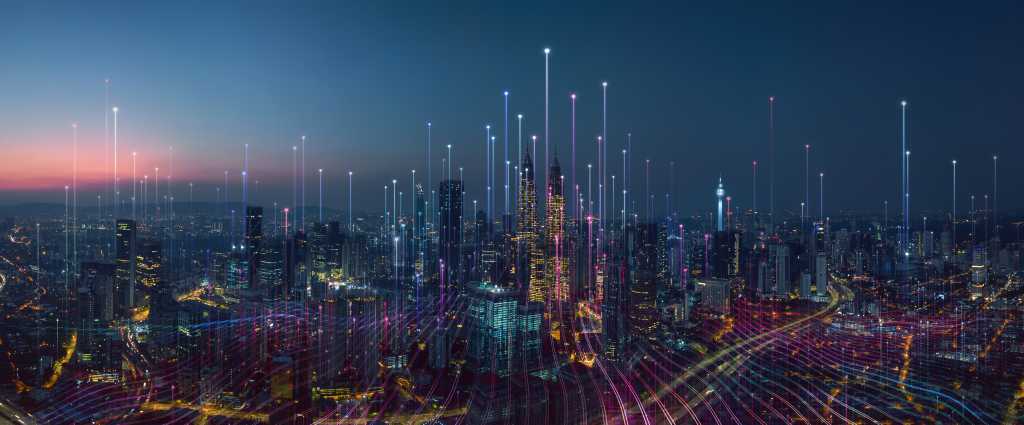The promise of the smarter city
Smart cities offer the promise of a thriving urban ecosystem that seamlessly blends technology, systems, and people to optimize everything from traffic flow to energy consumption. Public services in smart cities operating at peak efficiency, deliver convenient access to accurate information, resources, and community engagement essentials. Residents’ movements become effortless throughout the smart city, relying on optimized and efficient public transportation, connected vehicles, and intelligent adaptive traffic management. Behind the scenes, data augmented with artificial intelligence deliver insights to help enhance energy efficiency and promote sustainable urban development. All the while, robust security measures keep personal information safe and private. Through continuous technology development, cities experience adaptive transformative evolution at breakneck speeds, enabling smart cities to stay ahead of the curve by embracing new innovations.
In reality, cities pursuing this vision face multiple challenges related to simply maintaining existing critical infrastructure. From aging technology to physical degradation, municipalities must address a variety of issues to ensure the seamless functioning of essential services as their smart city plans evolve.
For these cities, fortifying Internet of Things (IoT) sensor and device vulnerabilities to combat cyberthreats is a key concern. As is safeguarding data privacy and security amidst an ever-growing network of connected systems. Communication networks need to be resilient to stand up to external disruptions. In addition, infrastructure needs to provide the flexibility to scale and keep pace with rapid technological advancements whilst incorporating the latest innovations in AI and generative AI (GenAI). As city officials forge ahead with smart city plans, these challenges must be tackled head-on to unlock a brighter, sustainable future.
The heart of the smart city: Modernized technology
Modernizing critical infrastructure components is the key to addressing these issues, improving data security and accuracy, as well as optimizing the management of city operations required for cities to continue supplying communities with the services they need to thrive.
While a commitment to modernizing IT and OT infrastructure is a crucial first step in building smart cities, it is just the first step. It is important to undertake modernization as part of a forward-thinking strategy to ensure infrastructure investments address current requirements and are adaptable, scalable, and resilient enough to handle future challenges. This requires thoughtful planning, strategic partnerships, and continuous innovation to create an infrastructure that harnesses the power of cutting-edge technologies, integrates seamlessly with existing systems, and supports the evolving needs of citizens, businesses, and the environment.
The smart city’s nervous system: Interconnected edge platforms
The next phase should be to establish a secure, interconnected framework of edge platforms to create a comprehensive centralized nervous system for the city. This system would serve as a unifying structure for securely integrating new devices while decoupling sensors, cameras, and other IoT components from applications throughout deployment and lifecycle management. By embracing this approach, cities can onboard new technology efficiently and securely while maintaining the agility to adapt to future advances and innovations. Ultimately, this framework helps enable smart cities to harness the full potential of their infrastructure investments and pave the way for a more sustainable, connected future.
Implementing this secure, interconnected smart city framework has the potential to yield significant results, transforming city services for the better. For example:
- City planning can be revolutionized through AI-driven urban digital twin models, predictive modeling, and simulations that empower city officials to make informed decisions, anticipate challenges, and proactively shape their future direction.
- Civil engineering critical infrastructure projects such as water, energy, bridges, roads, waste management, and fiber trenching will benefit from streamlined execution plans and improved collaboration for more efficient and timely completion.
- Carbon neutrality goals can be achieved through monitoring consumption patterns and establishing an environmental, social, and governance (ESG) baseline, fostering sustainable building practices and helping the city create a greener, more environmentally friendly future.
- AI-driven intelligent traffic management optimizes patterns and flows, reducing drive times, congestion-related pollution, and greenhouse gas emissions while also enhancing emergency response capabilities.
Planning for success
After assessing the desired outcomes and priorities outlined by city leadership in their strategic plan, the focus should shift to understanding which departments, systems, and subsystems are the most likely to benefit from improvements, and where digital transformation can help drive success. These details will define the starting point for formulating an action plan based on available budget and priority.
Partnering with technology leaders like Dell Technologies can help city leaders develop a prioritized plan with clear direction and a phased approach. This can help cities overcome common challenges such as increases in community demands, minimal resources, and limited budget, offering a path to demonstrate improvements that securely scale with ease.
As smart cities continue to evolve and embrace AI, GenAI and other innovative technologies, solutions like Dell NativeEdge provide a unified platform for managing the complex web of interconnected technologies that underpin smart city operations. Dell NativeEdge offers a single-pane-of-glass experience that enables city administrators to efficiently orchestrate various systems, keeping smart infrastructures manageable, secure, and ready for future expansion. With Dell NativeEdge at the core, smart cities can effectively transform urban spaces into more livable, sustainable environments that improve the quality of life for all citizens.
Learn More: Dell.com/DigitalCities

